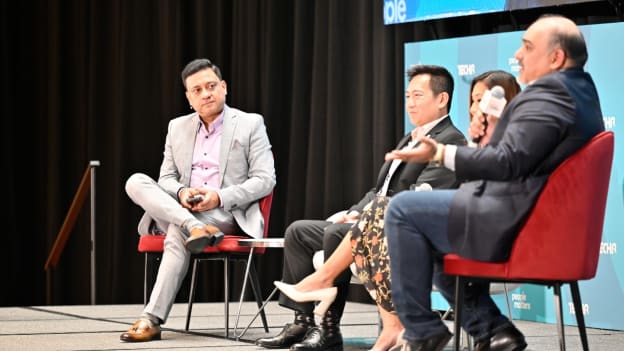How to foster a culture of innovation

A culture of innovation in the workplace refers to an environment that fosters and encourages the generation, exploration, and implementation of new ideas, processes, products, or services. This type of culture is characterized by open-mindedness, collaboration, experimentation, and a willingness to challenge the status quo.
Creating and sustaining a culture of innovation requires continuous effort and commitment from all levels of the organisation. When done effectively, such a culture can drive growth, competitiveness, and long-term success.
Moderated by Puneet Swani of Mercer, industry captions like Shayan Hazir; HSBC, Lawrence Goh; UOB, Puneet Swani; Mercer, and Lynn Dang; Snapchat converged together at the People Matters TechHR Singapore 2023 to deliberate on the elements of creating and nurturing a culture of innovation.
Leaders are of the view that diverse hiring, and empowering people to make decisions are some of the basic elements of creating and nurturing a culture of innovation in the workplace.
On how to create a balance between being innovative and delivering the day-to-day work, Lawrence Loh, Managing Director and Group Head of business banking at UOB, said that innovation has to be done in a very balanced way so that you can deliver the right thing and benefits to your customer and set a balance against risk.
For Lynn Dang, Director, People APAC, Snapchat, curiosity is the way to innovation in the workplace. “The industry I work for defines innovation as a way to create value to serve our customers and us, as well.”
Shayan Hazir, Chief Digital Officer, Southeast Asia, HSBC Singapore, described innovation as creativity illuminated. “There are two parts to it. Are we creating the right environment for creativity to thrive? And once we let that happen, do we allow for it to have the right air to breathe and thrive to become something tangible,” said Shayan Hazir. According to him, the other side of innovation is dimensioning the newness of the technology and its impact on the market. Innovation can be incremental, sain, radical, and it can be disruptive and all organizations have some version or percentage of those four happening at any given time. Hence, it's up to us to allow that creativity to illuminate itself. Maybe within some constraints. structure that allows for it to become pervasive and part of the organization. To drive innovation in an organistaion requires a bit of both romanticism and creativity.
Encouraging employees to innovation
Employees are an asset and building block of any organisation. How they should be encouraged to be innovative. Should it be there in their KPIs, there be any reward for them?
“To encourage employees and staff to be innovative, it is important to teach them the skills to identify the problem that needs to be solved. The second thing that is important for them is to be aware of the technology, process, and people that could be used to solve the matrix of the problem. To solve the problem, it is important to have the skills to identify the problem,” said Lawrence Goh.
Talking further on having an innovative workforce, Lawrence said that those who cannot see the problem cannot be innovative. We make sure that our people are skilled to understand the problem, where they can push their boundaries.
Sharing Snapchat’s way to help their workforce be innovative, Lynn Dang said that their focus is more on cultivating the creative ability of their employees. Besides creativity, succession learning from failure is what we focus on. Around the creativity pillar, we talk about succession learning, not just successes, but actually learning from your failures and experimentation,” said Lynn Dang. Feedback and communication are other aspects that help people to be more innovative. “The feedback helps in understanding the concepts better and creates an environment conducive to learning and growth.”
Who drives the innovation within organisational context
Highlighting the constant evolution of innovative concepts, Shayan Hazir explained that ownership of innovation and driving the innovation agenda are critical aspects, much like the approach exemplified by Steve Jobs.
“His reputation for technological innovation, as evident from the past decade, showcases the ongoing and dynamic nature of innovation. In such a context, innovation discussions have evolved from mobile and cloud technologies to the current blockchain and beyond, highlighting the constant evolution of innovative concepts. This underlines the necessity of infusing change into the organisation's framework, serving as conduits for delivering remarkable customer experiences and unique value propositions to employees.”
However, achieving this doesn't hinge solely on the involvement of the 20 most creative individuals. Although including creative minds in brainstorming sessions is beneficial, true innovation necessitates a comprehensive approach. This approach involves avoiding the temptation to confine creative thinkers to bean bag-filled rooms, which could inadvertently limit their impact. Instead, a more effective strategy is to establish clarity in ownership, particularly from top leadership.
“Here HR professionals have a specific role to ensure ownership among employees. Their role is to mandate change at all levels of the organisation. Before KPI, it is ownership and responsibility that inspire people to be innovative.”
Innovation amid technological disruption
Technology is evolving every day. How can organisations balance leadership innovation amid the technology disruptions happening?
It is not technology, in fact, the right application of technology that boosts our innovation, believes Lawrence.
“You can innovate on the processes of the way we service, so it doesn't necessarily need technology. However, if you know how to apply the right technology, then of course, it will solve the problem. We are not going to play with all the technologies. So, we are a little bit more targeted in the way we look at this. When we understand the market, we can make a difference to the customer,” added Lawrence.














